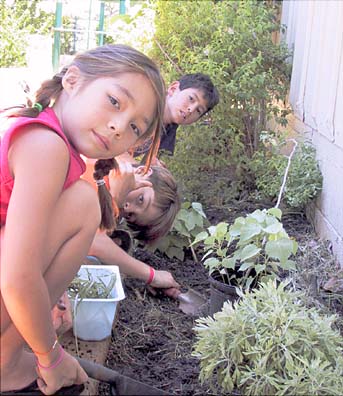


|
Education sprouts WAILUKU >> "Some birds need this plant," said 8-year-old Angelique Fontaine, as she planted a seed from a native olapa tree. "Without the plants, the animals don't live."
in garden on Maui
A school receives a grant to teach
kids about native plantsBy Gary T. Kubota
gkubota@starbulletin.comTrees become forests, which become home to tree snails and insects, she explained. The snails and insects are food for the rare po'ouli bird as well as other birds.
Without enough food, the po'ouli will die. That's why planting trees is important to Hawaii's environment, Angelique said, as she stood next to a garden of seedlings at St. Anthony Grade School in Wailuku.
The garden is a project funded by a $9,600 Toyota Tapestry grant from the National Science Teachers Association. It has become an outdoor classroom with more than 30 native species, offering hands-on lessons in Hawaii's native ecology.
The children learned not only how to grow native Hawaiian plants but also recruited families, businesses, and community groups to do the same.
"The idea is to change mentalities, and here's a start," said Delos Santos-Duarte, who worked with fellow teacher Teri Lynn Tavares to write the grant.
"People are amazed how much the children know. I think a lot of times we forget that kids' minds are so open."
The children learned about the connection among birds, insects and plants, from nectar retrieval to pollination.
Delos Santos-Duarte said a number of endemic plants unique grow only in certain locations on Maui. When removed from their natural setting, some native plants struggle to survive.
"You don't want to deplete the forest," she said, adding the youngsters were taught the importance of leaving native plants undisturbed in the forest.
The project also offers a lesson in native culture. The children learned that in the Hawaiian language, olapa is not only a tree but also a metaphor for describing an ancient form of the hula that sometimes mimics the movement of the leaves of the tree in the wind.
The project inspired one student to proclaim that one day she would be a wildlife biologist. "It kind of opens kids' minds to other possibilities out there," Delos Santos-Duarte said.
The project initially was designed for kindergartners and second graders but interest in it has spread throughout the school, which has more than 190 students.
Teachers and students have developed a brochure, "Planting A Native Future," to help identify appropriate native plants and suitable conditions.
The project has garnered much community support. Maui Irrigation Systems donated materials to build the nursery while Ho'olawa Farms and others contributed seeds.
Experts such as William Jacinto, a Maui Community College agricultural official, and John Medeiros, a state wildlife biologist involved in the propagation of endangered nene birds, have pitched in to help.
Delos Santos-Duarte said although funding for the nine-month project ended in May, she plans to continue the program with Tavares. They're currently operating the nursery with youths from the school's Summer Care Program.